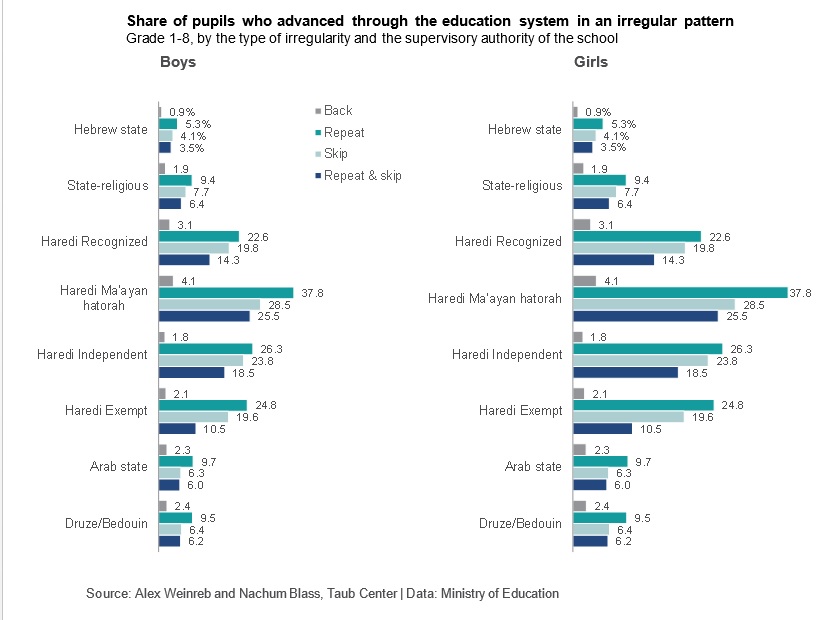Irregular patterns of student progression from first to eighth grade – such as skipping grades, repeating grades, being dropped down to an earlier grade, or some combination of these patterns – are more commonly reported in certain streams of Israel’s education system than in others. In this study, Taub Center Principal researchers Prof. Alex Weinreb and Nachum Blass found that irregular patterns of progression are more common in the Haredi sector, and, in particular, in the Ma’ayan Hahinuch Hatorani education system, than in the Hebrew state, state-religious, or Arab education systems. The research looks comprehensively and methodically at data for students enrolled in grades 1 through 8 between 2001 and 2015.
In theory, irregular patterns in the education system are meant to answer individual educational needs for students who for various reasons did not complete a grade successfully or performed at a particularly high level and needed the challenge of a higher grade. However, when the reported rates of irregular patterns are very high, it may be an indication that these patterns reflect the school’s organizational and management needs rather than students’ individual educational needs.
Boys advance in irregular patterns at a higher rate than girls
In general, boys go through the system in a less standard fashion than girls. The likelihood of a boy repeating a grade, being put back in a previously completed grade or skipping to a higher grade is almost twice that of a girl. This is not so surprising given that previous research has shown that, in general, the share of boys among the population of those with special educational needs – both those with disciplinary and educational needs – is higher than the share of girls with special needs.
The highest rate of irregular patterns is in the Haredi educational sector
In the Hebrew state system there were the lowest rates of irregular patterns. In this stream, only about 5% of boys and 3% of girls repeated a grade and about 3.5% of boys and 2% of girls repeated and then skipped a grade.
In contrast, the most irregular advancement patterns were found in the Haredi educational system. About 20% of boys who began school in Exempt educational institutions (which has little if any oversight by the Ministry of Education) repeated a grade, and about 10% repeated and then skipped a grade. In the Haredi Recognized system (schools that are partially financed by the state with partial oversight, although they are not officially part of the state system) about 23% of students repeated a grade and about 14% repeated and then skipped a grade. In the Independent system, about 26% of boys repeated a grade and about 18% repeated and then skipped a grade. In the Ma’ayan Hahinuch Hatorani schools the highest rates of irregular advancement were found: about 38% of boys repeated a grade and about 25% repeated and then skipped a grade.*
In the Arab education system (including Bedouin and Druze) and in the Hebrew state-religious system, the share of boys with irregular advancement patterns is higher than in the state system and low relative to the Haredi system. About 10% repeated a grade and about 6% repeated and then skipped a grade.
Among girls, the rate of irregular advancement patterns is lower, although the highest share is still in the Haredi educational system. In the Haredi Recognized schools, about 13% of girls repeated a grade and about 9% repeated and then skipped a grade. In the Ma’ayan Hahinuch Hatorani schools, about 21% repeated a grade and about 15% repeated and then skipped a grade. In contrast, in the Independent schools – where most Haredi girls study – advancement patterns are most similar to those of girls in the Hebrew state-religious system and the Arab, Druze and Bedouin system: about 7% of girls repeated a grade and about 5% repeated and then skipped a grade.
Irregular advancement patterns have increased in the Haredi education system over time
In the Hebrew state schools, as well as the state-religious and Arab education systems, patterns in irregular advancement remained relatively stable for each age cohort studied. In contrast, in the Haredi sector, students born in 2000 had a 50% higher chance of being put back in a previously completed grade or repeating a grade than those born in 1995.
When taking all the different types of irregularities into account for each sector, the average student in the Hebrew state system takes 1.015 years to complete a grade and to advance to the next grade – lower than the 1.025 years it takes in state-religious schools and the 1.029 years in the Arab schools. In the Haredi education system it takes 1.05 years to complete a grade in the Independent and Exempt schools, 1.06 years in the Recognized but not official schools, and about 1.09 years in the Ma’ayan Hahinuch Hatorani schools.
What does it mean?
There are substantial differences in the share of students with irregular patterns of progression depending on the school sector and supervisory authority. While the most standard patterns are in the state school system, the most irregular patterns are found within the various Haredi schools. The uncommonly high irregularities in reporting seem to be anchored in different school systems’ administrative practices and indicate that some schools freely intervene in the reporting or practice of student advancement.
*Independent schools in the Haredi sector are generally affiliated with the Agudat Yisrael political party, whereas the Ma’ayan Hahinuch Hatorani schools are affiliated with the Shas political party.




